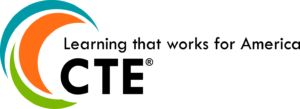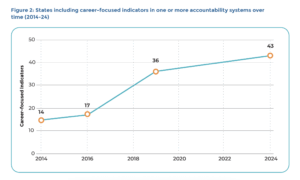“CTE Works” has been a rallying cry for Advance CTE and the field for over a decade. It signals that Career Technical Education (CTE), or “career tech,” is proven to offer unique benefits for learners, the economy, and communities. But for CTE to truly “work,” it must prepare learners from middle school through adulthood for any and all opportunities throughout their careers and lives.
Good news—there is growing evidence to support the rhetoric that CTE really works. A recent meta-analysis by the federally funded CTE Research Network found that CTE positively impacts high school outcomes, including academic achievement, graduation rates, employability skills, and college readiness. Importantly, the study also revealed secondary CTE learners are more likely to attend two-year colleges and were just as likely to attend four-year colleges as their non-CTE peers. These outcomes highlight CTE program quality, learner aspirations, and policies that enable successful postsecondary transitions.

CTE Research Network, What We Know About the Impact of Career and Technical Education: A Systematic Review of the Research, 2024
So, what makes an effective policy that values and incentivizes college AND career readiness?
My previous post discussed the ongoing tension between “college-ready” and “career-ready” expectations, which can send mixed signals or limit post-high school options. Here, I’ll explore how policy design—specifically graduation requirements, state accountability, and dual enrollment—can bridge or widen this gap.
High School Graduation Requirements
Graduation requirements set clear expectations for what learners need to complete—and know and be able to do—before leaving high school. Over the past two decades, many states have used graduation requirements to raise expectations and provide flexibility and personalization for learners.
Some states successfully balance college and career readiness through endorsements or seals that go above their core set of requirements. For instance, North Carolina requires a consistent “Future Ready Course of Study” but offers optional endorsements, including career and college. Similarly, Idaho provides optional STEM and CTE/Workforce diplomas.
Indiana’s new graduation requirements, which utilize various readiness seals—honors and honors plus—have gained a lot of attention recently. Learners earn these by completing “enrollment,” “employment,” or “enlistment” activities tailored to their interests. Crucially, these seals are in addition to consistent academic requirements that align with state public higher education admissions.
Unfortunately, these states remain outliers. Few states offer multiple, equally rigorous diplomas. Instead, too many states have distinct “college-ready” and “career-ready” diplomas. While well-intentioned, career diplomas often significantly reduce academic requirements, especially in math or science, to make room for more CTE. In these cases, students often have to choose which “track” – and, yes, these are tracks – before they even enter high school. History shows that when there are tracks in high school, certain (marginalized) learners are directed to certain tracks (and then further marginalized). Washington State is struggling with this issue right now and is overhauling their graduation pathways to ensure more consistent access and outcomes across student populations.
State Accountability
Accountability systems are another critical policy lever, providing direction—with “sticks and carrots”—to schools and districts on priority experiences and outcomes. Since 2014, states have overwhelmingly embraced career readiness in these systems; 43 states now include at least one measure, a threefold increase in a decade.
As Advance CTE has highlighted, the most common strategy for elevating college and career readiness in accountability systems is allowing districts credit if learners demonstrate at least one indicator of college or career readiness via “meta-indicators.” While flexible, meta-indicators can obscure which specific indicators students are achieving.
Despite the limitations of meta-indicators, the fact that so many states value career-ready and college-ready indicators equally is a significant advancement, validating the importance of both.
Models exist for states to emphasize the “and,” setting expectations for all students to leave high school with both college- and career-ready experiences. Delaware uses a meta-indicator with eight ways for learners to demonstrate readiness, but also offers bonus points for those who meet one college and one career preparedness option.
Virginia recently adopted its “3E Readiness model,” incentivizing and measuring learner engagement in Enrollment, Employment, and Enlistment, similar to Indiana’s diploma seals. Virginia’s system awards points across all 3E indicators, encouraging schools to support students in pursuing multiple postsecondary pathways. For example, a CTE completer with a high-quality work-based learning experience earns 0.5 points, while one who also earns a state-approved industry credential earns 1.5 points. Similar equivalents exist for the “enrollment” domain (e.g., early postsecondary opportunity for 0.5 points, associate’s degree for 1.5 points).
“3E is an ‘and’ model and awards points across all 3E readiness indicators, incentivizing schools to provide the support for students to pursue a variety of possibilities in employment, enlistment, and/or enrollment to prepare for post-secondary pathway success.” –Virginia Department of Education website
Dual Enrollment Expansion in Career Technical Education (And Beyond)
With CTE coursework making up a significant portion of early college credits earned by high schoolers, states are continuing to build and support programs that connect secondary and postsecondary education via CTE. Kentucky, for example, offers both a “Dual Credit Scholarship” and a “Work Ready Dual Credit Scholarship,” each covering two dual credit courses per year in general education and CTE, respectively. These are complementary, allowing learners access to multiple forms of (subsidized) dual credit. Over just four years, the total number of learners in dual credit increased significantly, from 34,900 to 49,076, earning over 315,000 credit hours.
Ensuring accessible and meaningful dual enrollment opportunities requires intentional policies and supports. Dual enrollment can become a free-for-all without clear guardrails, policies, and advising to ensure learners have access to the right early postsecondary opportunities—not just any early postsecondary opportunities. However, dual enrollment is one policy area that consistently crosses over and even blends preparation for college and careers for learners.
When the AND of college and career readiness is centered in policies connected to high school graduation requirements, state accountability systems, and dual enrollments, we see systems that:
- Blend career readiness experiences with core academics
- Give learners multiple—and equally rigorous—options for course-taking
- Have the right incentives in place that lead to college and career-ready outcomes
- Use dual credit to encourage postsecondary persistence and elevate CTE program rigor
In doing so, we get closer to every learner accessing the experiences they need to achieve their vision for success in college AND career.
The third and final blog in the Protect the ‘And’ series will focus on ways we can break the ‘or’ cycle and find new ways to remove the silos between career/CTE and college/core academics.




